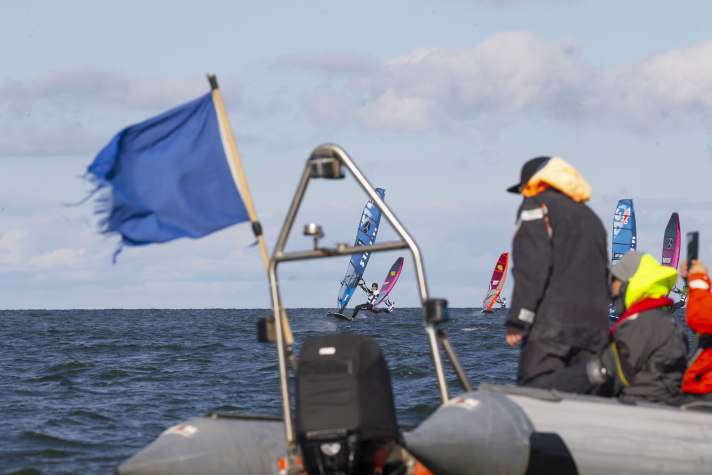PWA World Cup: These rules apply in wave riding, freestyle and slalom

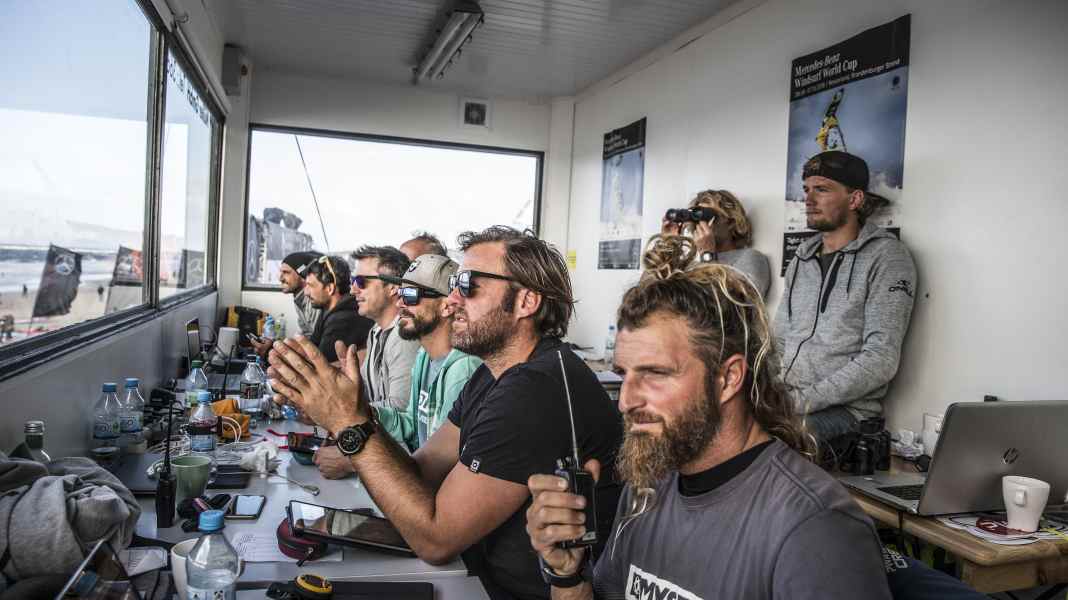
"Attention Competitors, this is an official announcement..." Spectators at the World Cup Sylt are familiar with these announcements that are made over the loudspeakers from time to time. But what does it actually mean? And how are the waveriding rankings determined? What do the riders do when they're not on the water? We give you an insight into the rules and procedures of windsurfing:
As an outdoor sport, windsurfing cannot be planned like a football match, for example. That's why the races have to be organised to suit the conditions as well as possible. For the World Cup Sylt, this means that wave riding takes priority in stronger winds, while the slalom pilots with their significantly larger sails and boards can also start in lighter winds. The foils pushed the wind limit down again significantly, so that official races are possible in winds of just under three forces. Freestylers need a little more wind, but not quite as much as the waver. They are also not dependent on optimal waves and are therefore somewhat more flexible.
Waveriding and freestyle: single and double elimination
In wave riding, jumps and wave rides are assessed, i.e. as many and radical turns as possible on a wave. Manoeuvres or jumps can also be incorporated into wave rides. The choice of waves is also included in the assessment. This means that tactics and experience count in addition to pure riding ability. The exact criteria will be announced at the skippers meeting. In freestyle, more complex manoeuvres and combinations are assessed, as well as versatility and skills on both sides or riding directions (tacks).
The judges enter the scores for manoeuvres via a tablet and the respective points are then calculated automatically. Depending on the spot and conditions, only wave rides or only jumps can be assessed, for example. In the example below, the two best jumps and the best wave ride were included in the scoring (marked in green). While in waveriding you can try as many moves as possible, in freestyle the moves per side are sometimes limited. The stance can be changed almost in real time in the Livestream on the PWA page be pursued.
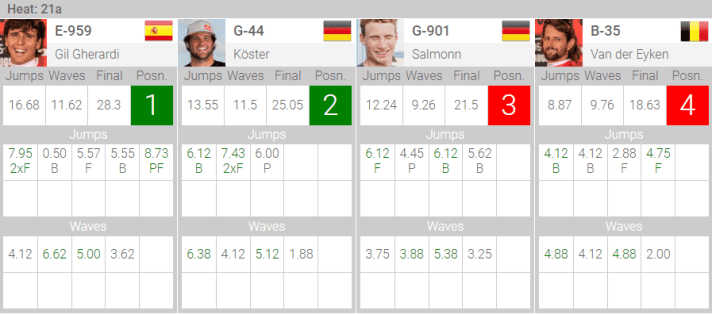
The surfers compete against each other in knockout rounds. They always start with the Single elimination. This means that whoever wins is through to the next round and whoever loses is eliminated (for the time being).
New mode in waveriding
Since the 2024 season, four riders always start together in a heat in wave riding, with the best two progressing to the next round. The winners from the first round then meet in the next round and so on. This saves time and makes the most of the conditions. After the quarter-finals, the format changes slightly: the four winners go straight through to the semi-finals, while the third and fourth-placed finishers compete again in an intermediate round. Three riders will then meet in the semi-finals, followed by the small and grand finals. At the end, there is one winner of the single elimination.
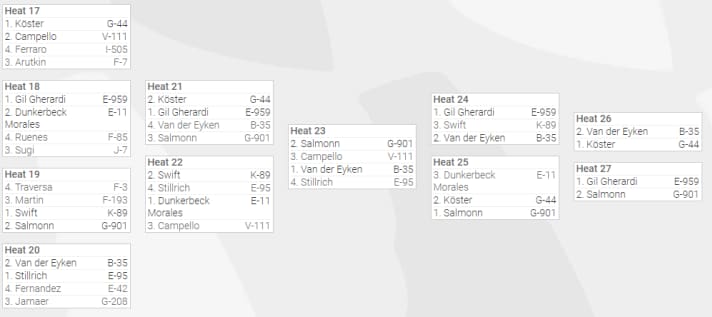
In the new mode, which was used for the first time in Pozo in 2024, the first eight places are already fixed after the single elimination. This should be attractive for spectators and the media, who can announce a certain winner early on. In the double elimination, only the places up to and including ninth place will be decided. The losers from the first round of the single elimination first compete against each other, the winners then meet the losers from the second round in the next round, and so it goes on round by round. Every driver therefore has the chance to improve their position from the single elimination. Everyone re-enters the action at the stage at which they were initially knocked out, while at the same time everyone is "allowed" to lose once. Numerous riders have been able to start a brilliant comeback after an early elimination.
It is still unclear whether the new mode on Sylt in 2024 will be a "small" double elimination or a full second round. The race committee will presumably decide this based on the forecasts, depending on whether there is enough time for a full double.
In a fully-fledged double elimination, as was customary in the WPA World Cup for many years, the best rider in the double then meets the winner of the single at the end. If the latter wins, he or she has won the event. However, if the previous winner loses, the two meet again in a so-called "super final" to decide who wins the event.
Only one double elimination per event is allowed in wave riding, several in freestyle. If the winner has already been decided but the conditions are still good, the race committee can organise a "super session". This does not count towards the official classification, but provides entertainment for spectators and sponsors, and other priorities can be set.
Foil Slalom: No rules - almost
In the slalom, the riders compete against each other in heats of eight, with the best four advancing to the next round. There they are then sent onto the water together with four winners from another heat. After the two semi-finals, the Winners Final and Losers Final will be held, which means that the losers will also race against each other once again to determine places 9 to 16. The rankings of the respective eliminations are only determined in the finals; the previous heats are all about progressing. Any number of eliminations can be ridden per event. Riders can cross off their worst result from four eliminations, the worst two from seven eliminations and three from twelve eliminations.
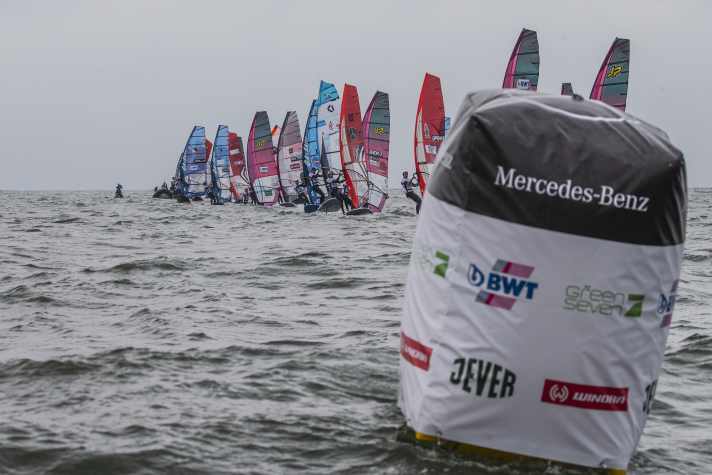
Since 2024, fin and foil have been separated: in Slalom X (not on Sylt), fins are used and there are optional obstacles on the course that have to be avoided or jumped over. There is also the Foil Slalom, which is also organised on Sylt. Thanks to the foils, the official wind limit could be reduced to five knots; previously it had to blow at least twelve knots.
Otherwise, "no rules" apply in slalom at the PWA. This means that there are no rules regarding right of way or courses to be followed. The race organisers can only intervene in the event of grossly unsportsmanlike or dangerous behaviour. In previous years, there were often numerous protests after the races, meaning that the winner was often not decided on the water, but in discussions with the judges. No rules" put a stop to this and made the races more exciting.
The course in the slalom is marked with buoys that have to be circumnavigated one after the other. A so-called downwind slalom is common, which means that the riders zigzag downwind. However, course races with more complex courses are also possible, especially in light winds, in which longer sections have to be completed on the cross - i.e. against the wind. These courses are tactically more demanding, but sometimes not quite as attractive to follow.
This is how a competition day at the World Cup works
The skippers meet every morning for the skippers' meeting. At this meeting, the regatta organisers determine which discipline is to be raced and which criteria are to be evaluated and which courses are planned for the slalom races. The heats, i.e. the pairs or small groups that are on the water together and race against each other, are also determined at this meeting. All heats are numbered consecutively and are started one after the other. If the forecast promises good conditions early in the morning, the skippers' meeting can also take place at dusk. All information can also be found on the official notice boards.
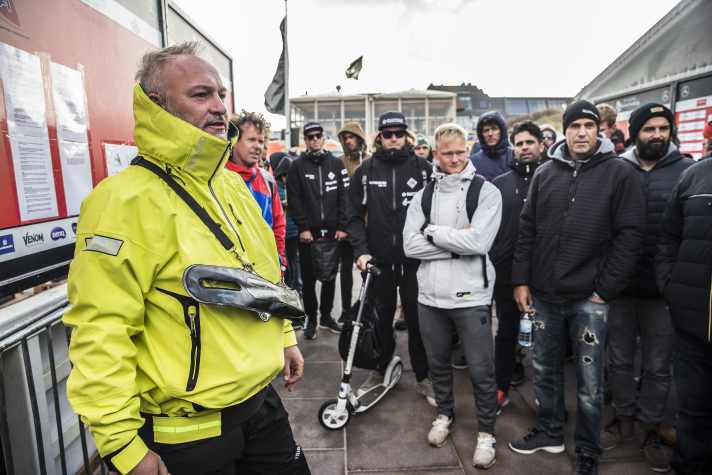
If the conditions are not sufficient, there are regular announcements for the riders throughout the day. The latest wind measurements are announced and the earliest time at which the race will start. This gives everyone enough time to prepare if necessary and get their equipment ready. The intervals between the announcements depend on the forecast: If there is a prospect of sufficient wind, announcements are made at short intervals; if there is a total calm, there are only two or three announcements per day.
When the starting signal is given, the competition day follows a previously announced rhythm. In slalom, for example, it is announced that a heat will start every 15 minutes; in wave riding or freestyle, ten minutes per heat and two minutes transition time would be a possible schedule. The riders can then work out when they have to start and set their race clocks accordingly. This way, they always have an overview on the water of how much time is left until their heat.
This is what the regatta organisers and judges do
The competition management consists of a regatta director, the head judge, and several additional judges. The central contact point on Sylt is the judges' container at the northern end of the promenade. From there, the judges have a good view of the water, and the official flag system is also located on the roof. This signals to riders and spectators whether, for example, a heat is currently in progress, whether the heat is being cancelled or how long it is until the next heat. When the flags change, there is usually also a sound signal.
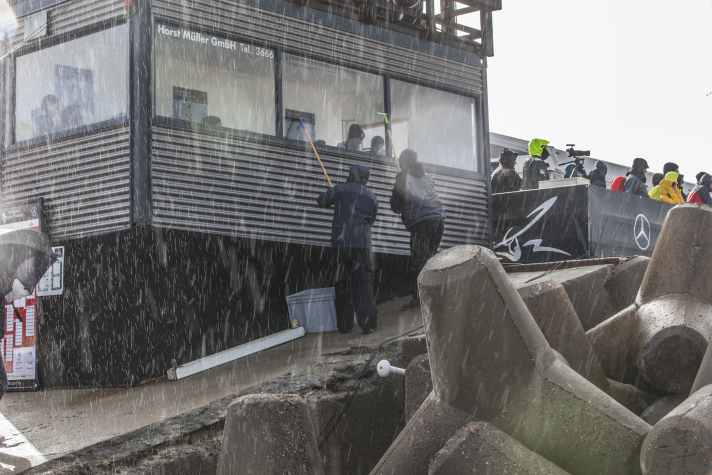
In waveriding and freestyle, the judges sit in the container and keep a close eye on the action on the water. They use a tablet to enter their scores for the jumps and manoeuvres, which can also be seen in the livestream shortly afterwards. In the skippers' meeting, it was announced beforehand how long the individual heats would be and what would be judged.
In the slalom, the head judge usually stays on land, all other judges are on the boats along the course on the water. There they monitor the starts and finishes and constantly check whether there is sufficient wind over the entire course. If the wind temporarily drops below 5 knots, the heat is cancelled and restarted later. If it becomes clear that the wind will not be sufficient in the long term, the riders are sent back ashore.
The starts in the slalom are particularly exciting: the racers try to cross the start line at full speed as close as possible to the start signal. One end of the starting line is marked with a buoy, the other end is the starting boat with the judges. The judges check that nobody crosses the start line even a fraction of a second too early. Anyone who is too fast and produces a false start is disqualified and the heat is cancelled. The judges on the finish boat monitor the finish accordingly.
